Exhibitions Great and Small
Frank Sharman
Exhibitions are an interesting and important part of the economic, social and
cultural life of Wolverhampton. This is an outline account, mainly taken from
secondary sources. All parts of it might make interesting subjects for others to
research further.
The context of the Wolverhampton Exhibitions
The idea of holding art and industrial exhibitions, of which the Great
Exhibition of 1851 is the best known example, did not pass Wolverhampton by. Its
most notable efforts were in 1869 and 1902; but there were other examples too.
The origins of such exhibitions seem to go back to France in 1797, where the
aim of the exhibition seems to have been to sell French products, mainly to the
French, because the English blockade was making it difficult to sell them
elsewhere. But the aim was also educational and propagandist - to persuade the
French that they could produce industrial goods as well as the English. Numerous
other such exhibitions, almost exclusively French in content and character,
followed at irregular intervals until in 1849 a massive exhibition in temporary
buildings in the Champs Elysee attracted a great deal of international
attention. A number of other European countries also held similar exhibitions,
closely modeled on the French, in the first half of the century.
In the UK exhibitions of a similar character, but much smaller in scale, were
organised by what was later to become the Royal Society of Arts. Their motive
was not commercial but mainly intellectual - they were interested in encouraging
and learning about new scientific and design developments. This notion was taken
up by the Mechanics Institutes, which promoted a large exhibition in Manchester
in 1837 which was followed by many smaller exhibitions put on by Institutes in
many northern towns. The Mechanics Institutes added a new dimension to the
exhibitions - they were trying to persuade the working classes (or, more
specifically, the skilled workers, artisans and craftsman) that their products
were worthy of note and could take the benefits of modern processes and good
design. (The above is based largely on: Paul Greenhalgh, Ephemeral Vistas: the
Exposition Universelles, Great Exhibitions and World's Fairs 1851-1939,
Manchester University Press, 1988).
Sometime during this period Wolverhampton seems to have joined in. Upton
(Chris Upton, A History of Wolverhampton, Phillimore, 1998) records: "The
earliest of these exhibitions was the brain child of George Wallis, an artist
employed by the firm of Ryton and Walton in Turton's Hall. The exhibition was
held in the Mechanics' Institute in Queen Street and showed both fine art
(including paintings by Rembrandt and Claude) and the latest in designer
furniture and decorated trays, as well as a variety of ironwork, locks and steel
toys". The inclusion of fine art in an exhibition of this period was unusual and
the mention of Claude may be significant. The decorators of japanned and similar
wares tend to look to fine art as an inspiration and exemplar. Claude was a well
known French landscapist the style and content of whose work often seems to be
reflected in the landscapes appearing on decorated wares. (I suspect that the
decoration on the relatively cheap wares produced in Wolverhampton - a town
which was an important canal centre - may have been influential in the
development of the "roses and castles" style of folk art found on canal boats.)
The Great Exhibition of 1851 seems to have taken all of the motives behind
the earlier exhibitions and rolled them together - the Great Exhibition was to
serve all the purposes of all the people. But the main organizer (with the
enthusiastic blessing of Prince Albert) added a further and vital ingredient -
that the exhibition should not just be nationally based but should be
international. Foreign exhibitors were to be important - and they came to the
1851 exhibition in droves.
| |
|
| Read about Wolverhampton's contribution
to the 1851 exhibition |
 |
| |
|
The 1851 exhibition set the tone and standard for all the subsequent Great or
Universal Exhibitions which sprang up around the world immediately after 1851
and which continued throughout this century and remain with us in the form of
World Fairs. Only a few elements remained to be added. In the Paris Universal
Exhibition of 1855 fine art was added on a large scale. The 1851 exhibition had
concerned itself almost exclusively with applied or industrial art, which is, on
the whole, what we would call design and ornament. Arts for art's sake came
later. The French exhibition of 1855 also added another feature: the 1851
exhibition was housed in one huge building, the Crystal Palace; the 1855
exhibition was split between numerous pavilions; and this became the standard
practice. Indeed exhibition architecture had been invented. Many, and sometimes
all, of the buildings in an exhibition were temporary and were used as exercises
in experimenting with new architecture or making over-cooked displays of the
old. Sometimes some buildings were designed to be a permanent addition to the
townscape - Wembley Way is full of the remnants of the Wembley Exhibition, the
Festival Hall is a dour remnant of the Festival of Britain and the Atomium in
Brussels is a leftover from a World Fair. Of all the weird and wonderful
buildings constructed for exhibitions before the Great War only Melbourne's main
exhibition hall seems to have survived. (see generally: Wolfgang Friebe,
Buildings of the World Exhibitions, Editions Leipzig, 1985.
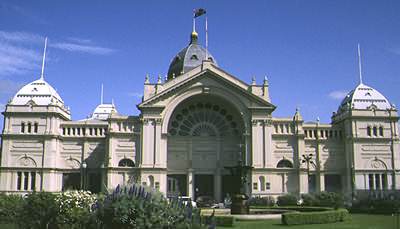 |
The main hall of the
Centennial International Exhibition, Melbourne, Australia,
1888/89. This seems to be the only one of all the pre-Great War
exhibition Halls to survive. Mostly classical, slightly
frenchified, it is typical of the ornately bombastic style of
great exhibition buildings. The Eifel Tower is another reminder
of exhibitions long gone. |
One further element was required: the entertainment. The earliest fairs had
been strictly edifying in tone but the patronising classes had noted, with
amazement and satisfaction, that the working classes had flocked to the Great
Exhibition of 1851. Perhaps because of this, funfairs and the like were, for
several decades, minor parts, if officially present at all, of most British
exhibitions. But the French, again, in the Paris Universal Exhibition of 1867
tried to attract crowds by providing a funfair and also by making the exhibits
more entertaining - you could ride the helter-skelter then go and watch African
natives doing tribal dances. The great exhibitions were nothing if not
imperialist and racist. Indeed at the turn of the century the British had taken
to promoting a whole series of National Imperial Exhibitions, whose major
purpose was to defend the idea of empire. It seems that Wolverhampton hosted one
of the bigger of these in 1907. (John M. McKenzie, Propaganda and Empire: the
Manipulation of British Public Opinion 1880-1960, Manchester University Press,
1985).
Wolverhampton Exhibitions
Upton records that: "An exhibition of the Industrial Arts was held at St
Leonard's Schools in Bilston in June 1859, opened by Sir Robert Peel...".
In May 1869 Wolverhampton made a bolder step towards its own version of the
Great Exhibition, when the Exhibition of Staffordshire Arts and Industry took
place in a temporary building in the Molineux Grounds.
| The Exhibition of
Staffordshire Arts and Industry, 1869. A contemporary
photograph, with Molineux House in the right background and the
temporary exhibition building in the left background. |
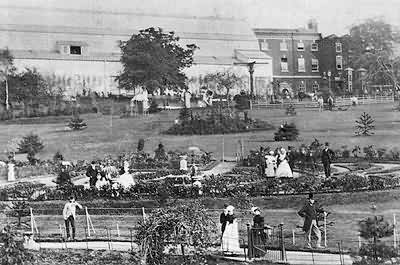 |
It was opened by Earl Granville on 11th May. Upton reproduces an extract from
the Earl's speech which encapsulates much of the thinking behind such
exhibitions: he said that "it was a high distinction for Wolverhampton that its
inhabitants should be among the first to erect a building specially for
promoting industrial art. The treasures of art and the products of skilled
industry, both part and present, collected within these walls are invaluable by
suggesting ideas and planting seeds that should bear good fruit in the future,
and instill into their minds a will and taste for the beautiful and the
refined".
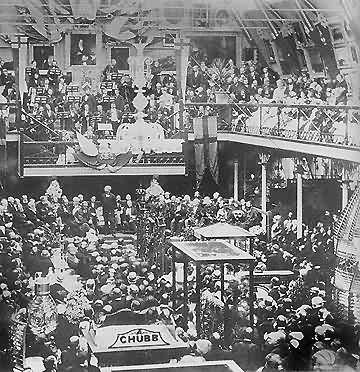 |
The Opening of the 1869
Exhibition. Presumably that is Lord Granville on stage,
spouting. There is an orchestra on the balcony behind him. The
large object, bottom right, seems to be most of the operative
part of a lighthouse. |
There seem to have been many other exhibitions of one sort or another in
Wolverhampton during the rest of the century, but the biggest and most ambitious
of them was the Arts and Industrial Exhibition which took place in 1902. This
great enterprise was fully in accord with all the developments in industrial
arts exhibitions up to that time, lacking only in international participation,
Canada being the only country to have a pavilion.
Mason (Frank Mason, The Book of Wolverhampton, Barracuda Books, 1979)
describes the opening by the Duke of Connaught (the King's brother): "...the
opening ceremony took place with a solid gold key studded with brilliants, and a
series of inaudible speeches. 'Its success' said the local press 'ought to be
exceed even the sanguine hopes of the promoters'. They could not have been more
in error. One of the worst summers on record ensured a loss of over £30,000 and
although some bold spirits were prepared to try again the following year, the
promoters had had enough".
The pictures here show what was on offer, as well as raising a number of
questions.
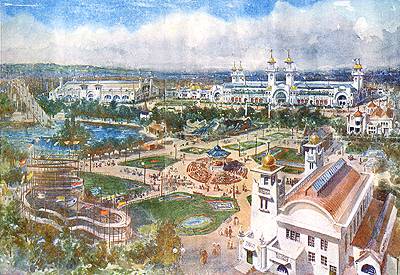 |
This colour print, from a
watercolour by George Phoenix, shows the whole exhibition. At the back
are the water chute, the Machinery Hall, the Canada Hall, the Industrial
Hall. At the right centre is the Shell Bandstand and Connaught
Restaurant. At the front are the spiral toboggan, the kiosk band stand
and the concert hall. |
| The entrance to the site. But what
road is it on? Is it Bath Road? |
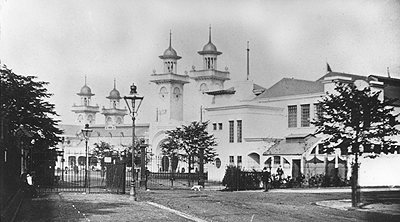 |
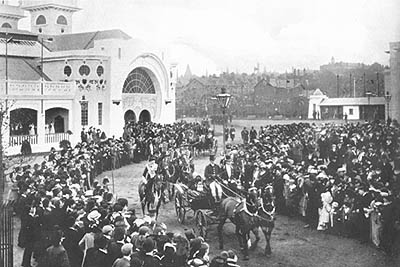 |
The Duke of Connaught arrives for the
opening ceremony. He is passing the Industry Hall. |
| The Industry Hall. The architectural
style - of the tops of the towers, at least - might be described as
Indo-Saracenic. The style of the rest is more debatable, though there is
a touch of art nouveau in the horeseshoe shaped entrances. |
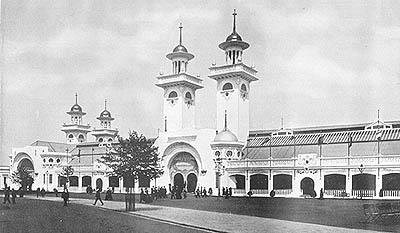 |
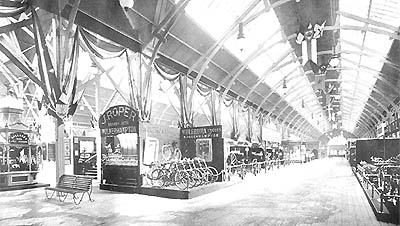 |
The interior of the Industry Hall |
| The Machinery Hall. Again, the style
defies description. |
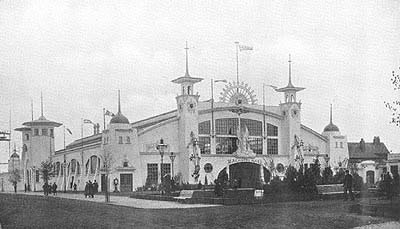 |
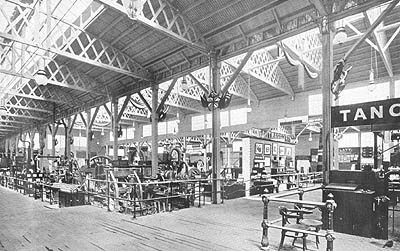 |
The interior of the Machinery Hall.
Compare the functional style of the interior with the oddity of the
exterior. |
| The Canada Hall. One might describe
this as stripped classical but it compares favourably with the other
pavilions. |
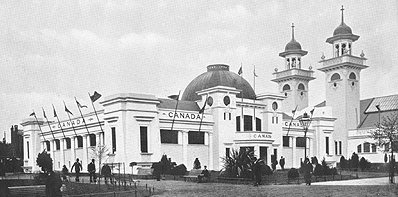 |
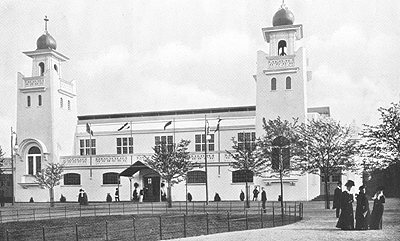 |
The Concert Hall. Indo-Saracenic
domes have been abandoned in favour of Eastern Orthodox onions; there
are also classical and Arabic features - quite a selection in a
basically plain design. |
| The Interior of the Concert Hall. It
seems strangely unornamented and the seats do not seem to be designed
for comfort. |
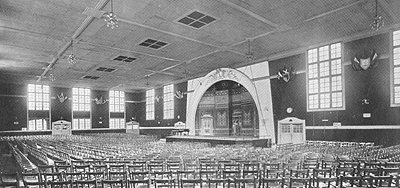 |
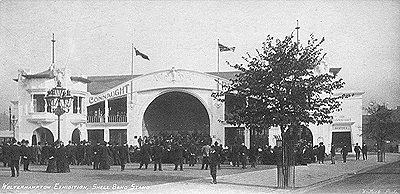 |
The Shell Bandstand. The doorway at
the right gave access to the Connaught Restaurant. |
|
The Water Chute. |
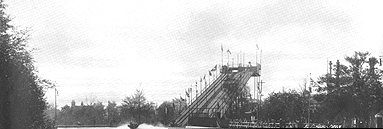 |
 |
The Spiral Toboggan |
| The Swan Boats. The passengers seem
to be seated in wicker chairs. A man in sailor's uniform sits astride at
the back. How were these boats propelled? |
 |
 |
A special stamp that was produced to
commemorate the 1902 exhibition. Courtesy
of Terry Furler. |
Wolverhampton Archives, amongst other material on the 1902 Exhibition, has,
on the open shelves, a complete set of the Daily Programmes of the Exhibition,
which detail what was happening at the Exhibition day by day.
Many of the Great Exhibitions, though temporary in themselves, altered the
cities in which they took place because of the clearances and changes made to
accommodate them, because of the buildings that remained and because of changes
to infrastructure. In its own little way Wolverhampton's great exhibition had a
little effect. The underground lavatories in Queen Square were dug out to
provide for the additional visitors expected in town; the Lorain system tramway
was hurried on so as to be ready for the opening: its first route was from the
town centre to the exhibition; and the bandstand in West Park may have been
built for the Exhibition..
Some later exhibitions
The 1869 and 1902 exhibitions can be seen as being within the tradition of
art and industrial exhibitions. But, of course, Wolverhampton hosted many other
exhibitions of all sorts, local and national. It may be worth noting, briefly,
some which have come to my attention and to invite others to do further study
these, and any further examples they may find.
The Royal Agricultural Society of England had run the annual Royal Show since
1839. In 1871 it came to Staffordshire for the first time. "On that occasion the
deputation who waited on the Council of the Society to support the invitation
was introduced by Mr. C. P. Villiers, who represented Wolverhampton in the House
of Commons for the long period of 63 years, and the claim was pressed
successfully by the then Mayor (Alderman Thomas Bantock)...". (The Book of
Wolverhampton: Souvenir of the Royal Show 1937, Wolverhampton Industrial
Development Association, nd (1937). The show was held on the old race course,
now West Park.
 |
The Royal Agricultural Show, 1871,
held on Wolverhampton Race Course (now West Park). In the left
background one can make out St.Peter's and the Town Hall. Is the church
just behind the stand (centre) supposed to be the Catholic Church on
Bath Road? On the right centre is the parade ring. The galleried
building left is signed "Wickham & Pickmere First Class Refreshments". |
The illustrated paper, "The Graphic", in its issue for the 21st July 1871,
published a whole page of wood blocks of the show. Three pictures are shown
here. (The other two are standard blocks of funny agricultural characters and
might have been drawn anywhere. As two of the pictures here show, "The Graphic"
seemed intent on amusing its sophisticated urban readers with illustrations of
amusing yokels).
| "Trial of Traction Engines at
Newbridge". Does anyone have the story behind this? |
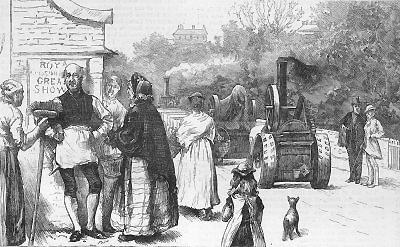 |
|
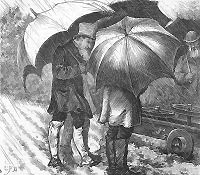
In the trial fields at Hopton. What is the
machine? Is it part
of a steam ploughing set up? |
|
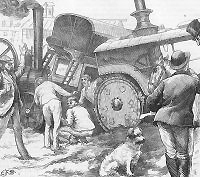
The Chenab (Government Steam Train) in the
Mud. Does anyone have the story behind this? |
In 1937 the Royal Show was again in Wolverhampton, this time in a very much
bigger form and at Wrotteseley Park.
These shows reflect the fact that Wolverhampton, for most of its history,
mainly got its living from agriculture. It was a centre for the rich arable
lands around as both the Exchange and the Agricultural Hall testify. In addition
Wolverhampton had been an important centre of the wool trade.
In 1937 one casualty of the Royal Show was what would have been the 45th
annual Wolverhampton Flower Show (which seems also to have been known as the
Floral Fete). This event claimed to be "in many respects ... unsurpassed for
many years and ranks next in importance to the great floral display at Chelsea."
The 1937 show was abandoned in favour of the Royal Show and this may have been,
if not the end of the Flower Show, the beginning of its end. The conservatory in
West Park is a legacy of these flower shows.
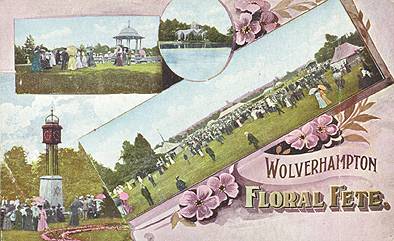 |
This undated, turn of the century,
coloured postcard, shows West Park and the clock, the band stand and the
conservatory. In the general view St.Peter's can just be made out on the
distant horizon. |
In 1951 the Festival of Britain had as great an effect on the country as the
old arts and industrial exhibitions were supposed to have, even though empire
gave way to commonwealth and the entertainment was shipped off from the South
Bank to Battersea Park. But the Festival was a festival of Britain, not just
London, and the organizing committee approved local exhibitions as part of the
Festival programme. In Wolverhampton the local exhibition, The Festival of
Wolverhampton, ran from 4th May to 19th May and was organised by Beatties, who
had 19 stands in their shop. The list of the exhibitors is almost a who's who of
Wolverhampton industry in the post war period: Express and Star, Villiers,
Goodyear, ECC, Courtaulds, J.Brockhouse and Orme Evans and Co, James Gibbons,
Butlers, Boulton Paul, Chubb, Ever Ready, Fischer Bearings, Henry Meadows,
H.J.Law, Star Aluminum, Qualcast, Guy Motors, Turner Manufacturing, Presto and
Tower Brands. (anon (Beatties), The Festival of Wolverhampton Exhibition
Souvenir programme, np (Beatties), nd (1951)). It may be a little sad to reflect
that great aspirations of 1902 had been reduced to some stands in a department
store for two weeks; and even sadder to reflect on how many of the exhibitors
are, in Wolverhampton at least, no more.
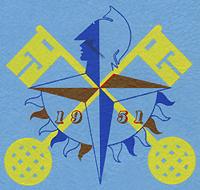 |
The symbol of the Festival of
Wolverhampton - the Festival of Britain symbol with the crossed keys of
St.Peter superimposed on it. |

|






















